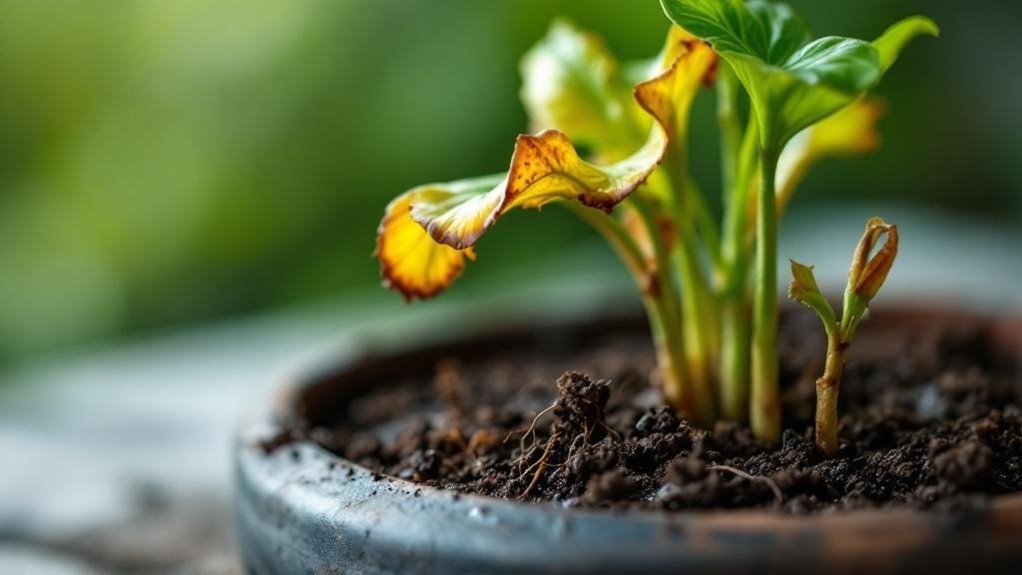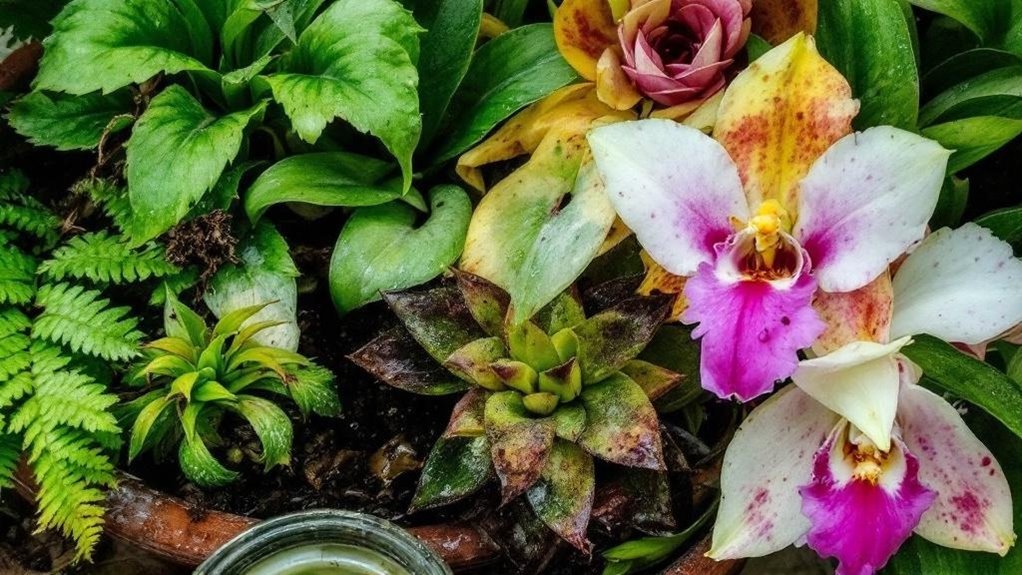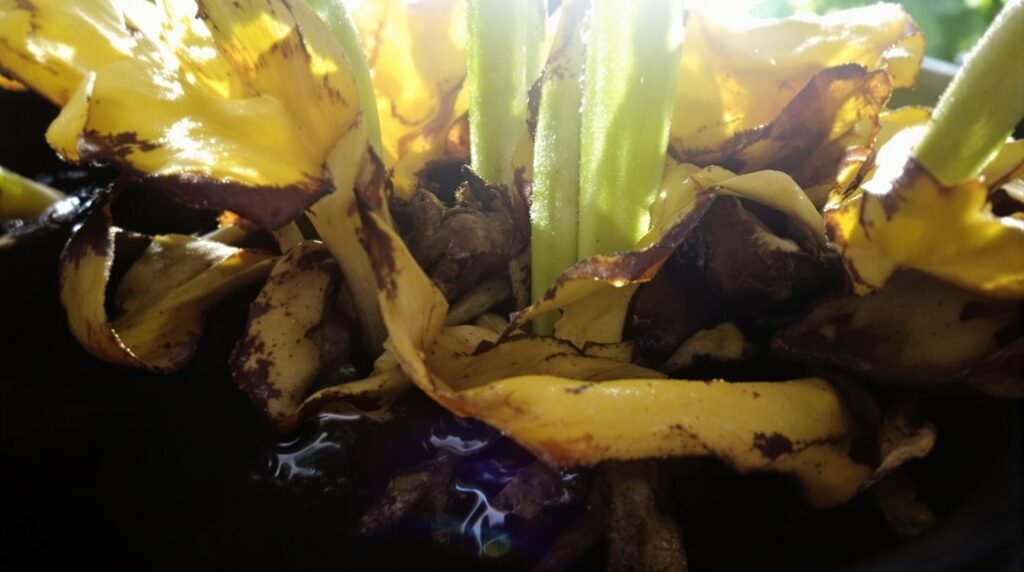Like a well-tuned instrument, your plants need just the right amount of water to thrive. Too much, and they start sending subtle distress signals—yellowing leaves, droopy stems, or even a strange smell from the soil. If you’ve noticed these signs but aren’t sure what’s going on, understanding the symptoms of overwatering can help you save your greenery before it’s too late.
Common Visual Indicators of Overwatered Plants
Yellowing leaves often signal that you’ve overwatered your plant, starting at the tips as the roots struggle to provide nutrients due to lack of oxygen.
Along with yellowing leaves, droopy leaves are a common visual indicator that your plant is suffering from root rot caused by waterlogged soil.
Droopy leaves alongside yellowing ones often reveal root rot from overly saturated soil.
Contrary to what you might think, wilting isn’t just a sign of underwatering—it often means the roots can’t breathe in overly wet conditions.
You might also notice brown, mushy leaf edges or algae growing on the soil surface. These are clear symptoms every gardener should know to catch early.
To confirm, always check the soil moisture before watering again. Recognizing these signs helps you save your plant before irreversible damage sets in.
How Overwatering Affects Plant Roots and Soil
When you notice droopy or discolored leaves, it’s a sign that overwatering is already affecting your plant’s roots and soil.
Overwatered roots struggle because saturated soil limits oxygen, causing suffocation and root rot. Poor drainage worsens soil compaction, reducing air pockets essential for healthy roots.
Waterlogged soil also encourages harmful molds and bacteria that damage roots further.
Watch for these signs of overwatering in your plant’s roots and soil:
- Roots turning black or brown instead of healthy white or yellow
- Soil staying constantly wet with poor drainage
- Soil compacting, reducing moisture and oxygen balance
- Presence of mold or foul smell indicating anaerobic conditions
Recognizing these symptoms helps you adjust watering habits before your plant suffers irreversible damage.
The Impact of Excess Water on Plant Growth

Although water is essential for plants, too much of it can suffocate their roots by depriving them of oxygen, which stunts growth and reduces metabolic activity.
Excess water suffocates plant roots by cutting off oxygen, hindering growth and metabolism.
When you overwater plants, their roots become waterlogged, sitting in wet soil that lacks proper aeration. This poor soil aeration prevents roots from absorbing nutrients efficiently, leading to yellow leaves and slow growth.
As the soil stays saturated, root rot can set in, damaging the root system beyond repair. Over time, waterlogged roots struggle to support the plant, causing wilting and leaf drop despite ample moisture.
To keep your plants healthy, it’s important to avoid consistently soggy soil, as excess water hinders root function and overall plant development.
Identifying Leaf and Soil Conditions Linked to Overwatering
Overwatering affects more than just the roots—it leaves clear signs on both leaves and soil that you can spot. When your plant’s soil feels soggy despite proper drainage holes, it’s a common issue of excess water.
Look for these symptoms:
- Yellow or brown leaves with soft, limp texture indicating stress.
- Algae or moss growth on the soil surface signaling constant moisture.
- Leaf drop following discoloration as roots suffocate.
- Edema: water-soaked lesions on leaves causing distorted foliage.
To confirm, use a moisture meter to check soil moisture levels before watering. Avoid watering if the soil still feels wet.
Keeping an eye on these leaf and soil conditions helps you catch overwatering early and keeps your plants healthy.
Symptoms of Overwatering in Different Plant Types

Since different plants react uniquely to excess moisture, recognizing specific symptoms can help you adjust your care routine effectively.
For example, overwatered plants like snake plants develop soft leaves and yellowing tips due to root rot caused by moist soil.
Parlor palms show drooping fronds and yellow edges, signaling poor drainage and oxygen deprivation at the roots.
Succulents exhibit squishy, translucent leaves, a clear warning from their drought-tolerant nature.
Pothos plants may have brown leaf spots and mushy stems, evidence their roots are struggling in saturated conditions.
Fiddle leaf figs often wilt, drop leaves, and brown at the edges when overwatered.
Steps to Revive an Overwatered Plant
Noticing the signs of overwatering is just the first step; taking action quickly can save your plant from further damage.
Recognizing overwatering early is crucial—prompt care can prevent lasting harm to your plant.
To revive an overwatered plant, you should focus on proper plant care and letting the soil dry fully before watering again. Here’s what to do:
- Stop watering and allow the soil to dry out completely for a few weeks.
- Check the moisture in the soil regularly using the finger test or a moisture meter.
- If the root ball is severely waterlogged, repot the plant, trimming away black or brown roots and using fresh potting soil.
- Clean the pot with disinfectant soap to prevent pathogens and consider placing the plant in a shadier spot.
Tips for Monitoring and Adjusting Watering Practices
To keep your plants healthy, you need to monitor soil moisture regularly and adjust your watering habits accordingly. Check soil moisture by inserting your fingers 1-2 inches into the soil or use a moisture meter to know when to water. Establish a consistent watering schedule, like “Water Wednesdays,” to stay on track. Remember, plants need less water during winter as growth slows. Use pots with drainage holes to prevent water buildup and guarantee proper drainage. Clear any clogs to avoid overwatering risks. Always watch for signs like yellowing leaves or wilting, which indicate overwatering. If these appear, let the soil dry completely before watering again. Additionally, a soil moisture meter like the SONKIR Soil pH Meter can provide quick and accurate readings to help you maintain optimal watering habits.
Frequently Asked Questions
How to Tell if Garden Plants Are Overwatered?
You can tell if your garden plants are overwatered when their leaves turn yellow or brown, stems feel mushy, leaves drop, soil stays wet, or you spot mold and fungus gnats around the base.
How to Fix Overwatered Garden Plants?
To fix overwatered plants, let the soil dry completely before watering again. Trim any black roots, repot in fresh soil if needed, guarantee proper drainage, and only water when the top inch of soil feels dry.
Final Thoughts
You might think more water means healthier plants, but overwatering can actually harm them. By recognizing signs like yellowing leaves, wilting, and soggy soil, you can prevent root rot and other issues. Remember, plants need balance—too much water suffocates roots and invites disease. So, check your soil moisture before watering and adjust accordingly. With these simple steps, you’ll keep your plants thriving and avoid common watering mistakes.
